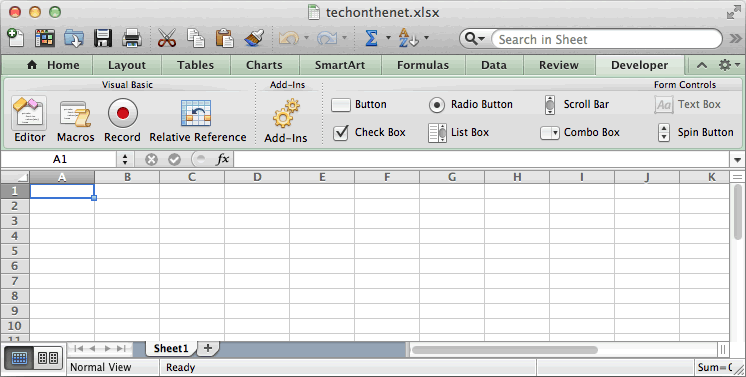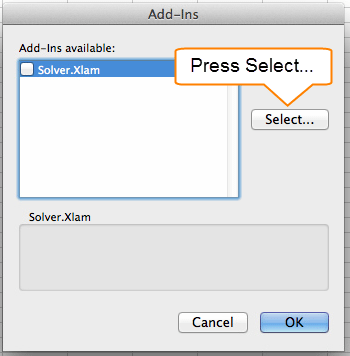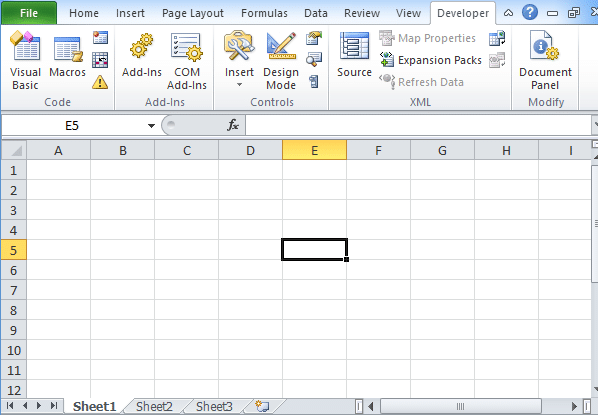Open the Add-ins Menu in Excel. Select the Tools menu in menu bar. Select the Add-Ins option. Press the Select button in the Add-Ins window. Find the add-in file that you saved on your computer in Step 1. Then press the Open button. The add-in file should now appear in the list of available add-ins in the Add-Ins window. This video explains how to install the Data Analysis Toolpak in Excel 2016 for Mac in order to do statistical calculations. It was prepared for a statistics. How to install Data Analysis and Solver Add ins to Excel 2016. Add-ins provide optional commands and features for Microsoft Excel. By default, add-ins are not immediately available in Excel, so you must first install and (in some cases) activate these add-ins so that you can use them. Some add-ins are built in to Excel, such as Solver and the Analysis ToolPak. Some other add-ins are available from the Download Center, and must first be downloaded.

An add-in enhances or works with Office 2011 for Mac software in some way. Add-ins are sometimes called plug-ins or add-ons. Here are three examples of excellent commercial-quality add-ins that work with Mac Office:
EndNote (www.endnote.com): A high-end bibliography product for Microsoft Word.
MathType (www.dessci.com/en/products/MathType_Mac): The full version of Equation Editor that’s included in Office. It lets you put mathematical symbols in Word, Excel, and PowerPoint.
TurningPoint (www.turningtechnologies.com): Use clickers to capture audience responses in real time and present the results on PowerPoint slides. This software is used in classrooms, quiz shows, marketing studies, and more.
Many add-ins made for Office for Windows can work on your Mac, so be sure to check their system requirements. Almost all add-ins can be made Mac-compatible with a little effort, but you may have to request the developer of a nonfunctioning add-in to make that extra effort.
You can put add-ins anywhere in Finder. If you want to make an add-in available to all Mac OS X user accounts on a computer, put them into Applications:Microsoft Office 14:Office:Add-Ins. The Documents folder is a good place to put add-ins to be used by a particular OS X user account.
A few commercially produced add-ins are installed using the Mac OS X installer program. Because making an installer is an art of its own and takes extra time and effort on the add-in developer’s part, you install most add-ins manually using the Add-Ins dialog in Office.
A Word add-in is a template file that contains VBA (Visual Basic Editor) code. You can add such a template to the Templates and Add-Ins dialog. In PowerPoint and Excel, an add-in has a special file extension and is not necessarily a template.
| Application | New Add-In File Extension | Old Add-In File Extension |
|---|---|---|
| Word | .dotm | .dot |
| Excel | .xlam | .xla |
| Excel macro enabled template | .xltm | .xlt |
| PowerPoint | .ppam | .ppa |
| PowerPoint macro enabled template | .potm | .pot |
To open the Add-Ins dialog, here’s what you do:
Word: Choose Tools→Templates and Add-Ins.
Excel and PowerPoint: Choose Tools→Add-Ins.
Word, Excel, and PowerPoint: Click the Developer tab on the Ribbon and then click Add-Ins→Add-Ins.
When you have the Add-Ins dialog open, you can do the following simple tasks to add, remove, load, and unload add-ins:
Load: Same as selecting the check box next to the add-in’s name. Loading also runs the add-in. (Available only in Excel and PowerPoint.)
Unload: Same as deselecting an add-in’s check box. Unloading disables the add-in. (Available only in Excel and PowerPoint.)
Add: Click to open the Choose a File browser, where you can browse to an add-in template in Finder and add your add-in to the list.
Remove: Click to remove the selected add-in from the list.
Add Ins Excel Mac 2011
In Word, when you select an add-in’s check box or click the Add button, you load the template, thereby making the VBA routines that it has available globally within all open documents in Word. A loaded template is called a global template. Revisit the Templates and Add-Ins dialog to re-load your template(s). To disable an add-in, deselect its check box or click the Remove button.
Excel and PowerPoint add-ins are also loaded and unloaded using check boxes. When you close Excel or PowerPoint, add-ins that were loaded at closing reload themselves when you reopen the application.
As the article suggests, today we will learn how to add Analysis ToolPak in Excel For Mac and Windows PCs. So let's get started.
The Analysis ToolPak is an add-on in Microsoft Excel. By default, this add-in is not installed in Excel.
Analysis toolPak of excel contains very helpful tools for statistical, financial, and engineering data analysis.
How to Add Analysis ToolPak to Excel 2016 in Windows?
To install the Analysis toolPak in Excel 2016 follow these steps.
- Click on file.
- Click on option. You’ll see the excel options dialogue box.
- Click on Add-Ins. It is on the left, second option from the bottom.
- Locate Analysis ToolPack and click on it.
- In the bottom, you must be able to see manage drop down. Select Excel-Add-ins and click on Go button.
- All available Add-ins will be shown to you. Select Analysis Toolpak and click OK.
Analysis ToolPak is added now. You can see it in the Data tab in the rightmost corner.
How to Add Analysis ToolPak in Excel 2016 for Mac?


To install Analysis toolpak in Excel for Mac, follow below steps.
- Goto tools or Insert menu.
- Locate Add-Ins and Click on it.
- You’ll be prompted to choose from available add-ins. Select Analysis Toolpak.
- Click Ok.
Analysis Toolpak is added. Goto data tab. In the rightmost corner you’ll find Analysis Toolpak waiting for you.
Analysis Toolpak has a number of useful statical tools that we will explore in our that we have explored in analysis tutorials.
The Analysis ToolPak in Excel 2010
Steps for a user to manually install Analysis ToolPak in Excel:
Excel Add Ins 2019
- Click on File ribbon
- Click on Options
- From Options, select Add-Ins
- Select Analysis ToolPak and click on Go button
Outlook For Mac Add Ins
- You can see 4 Add-Ins options are available, check the Analysis ToolPak
- Click on OK button
- When you check Data ribbon, this time you will see Data Analysis option appears in Analysis Group.
- When you click on Data Analysis, you will find the dialog box as shown below:
There are a total of 19 options available in the Data Analysis:

1. Anova: Single Factor
2. Anova: Two-Factor with Replication
3. Anova: Two-Factor without Replication
4. Correlation
5. Covariance
6. Descriptive Statistics
7. Exponential Smoothing
8. F-Test Two Sample for Variance
9. Fourier Analysis
10. Histogram
11. Moving Average
12. Random Number Generation
13. Rank and Percentile
14. Regression
15. Sampling
16. t-Test: Paired Two Sample for Means
17. t-Test: Two-Sample Assuming Equal Variances
18. t-Test: Two-Sample Assuming Unequal Variances
19. Z-Test: Two-Samples for Mean
An add-in is simply a hidden tool that adds new features in Microsoft Excel 2010 and 2013.

Related Articles:
Label printer for mac. It will be shown as a number such as xx:xx:xx:xx:xx.xxThere are a couple methods of obtaining the Mac Address using the Zebra Setup Utility communications window. Topic or InformationHow do I find the Mac Address on the printer?Is the Mac Address of the printer on the exterior?Applies ToZebra Bar Code Label PrintersDetailsThe Mac Address is typically located on an external label either on the back or bottom of the printer.
Popular Articles:
